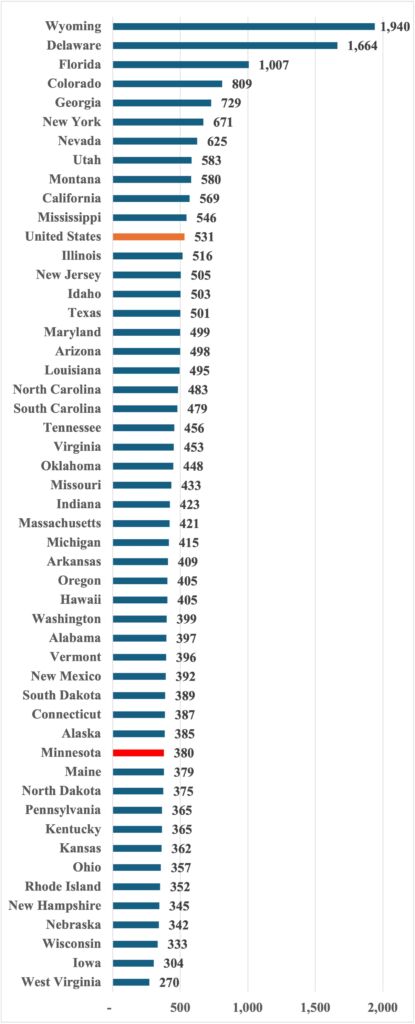Minnesota continues to fall behind in creating new businesses
Entrepreneurship is the engine of growth in the economy. New businesses are not only responsible for creating the majority of new jobs, but they also have an outsized impact on innovation as well as productivity growth. New businesses also enhance competition, improving the allocation of resources. This improves efficiency, leading to income gains that are spread all around the economy.
Unfortunately, however, Minnesota has consistently fallen behind in creating new businesses.
According to data from the US Census Bureau, for example, last year, Minnesota had a total of 69,210 business applications. Adjusted for population, this translates to 1,206 per 100,000 people, which was below the national rate of 1,637. Among the 50 states, Minnesota ranked number 38.
Not all business applications turn out to be employers, however. Luckily, the US Census Bureau also reports those businesses that are likely, and be able to employ people in a separate category called High Propensity businesses. Minnesota’s performance was similar in this category as well.
In 2023, the rate of high-propensity business formation for Minnesota was 380 per 100,000 people. This was below the national rate of 531. Minnesota also ranked number 38 among the 50 states.
Figure 1: Number of High Propensity Business Applications per 100,000 people

Source: U.S. Census Bureau
This is a trend that, unfortunately, has persisted over time. Looking at the period since 2010, Minnesota has ranked behind the nation in creating businesses. Minnesota also ranked behind the median state throughout the whole period between 2010 and 2023.
Figure 2: Number of High Propensity Business Applications per 100,000 people, 2010-2023

Source: U.S. Census Bureau
Data from the Bureau of Labor Statistics (BLS) on the age of private sector business establishments show a similar concerning trend. In 2023, Minnesota had one of the country’s smallest share of private sector businesses aged 5 years and under, ranking ahead of just three states — Iowa, Ohio, and Pennsylvania. While the national share of private sector business establishments aged 5 and under was 41 percent, in Minnesota, it was 34 percent.
Figure 3: Share of private sector business establishments that are 5 years and under, 2023

Source: Bureau of Labor Statistics
Cause for concern
Minnesota’s economy certainly has some strengths. For one, we tend to rank well on dynamism. But that is mainly due to our high rate of labor force participation as well as a high rate of innovation.
Looking at the most important side of dynamism, however — turning ideas into new businesses — we do not do so well.
If Minnesota’s economy is going to improve, especially with changing demographics, it needs entrepreneurship. And that is why our lackluster track in creating new businesses should be concerning.